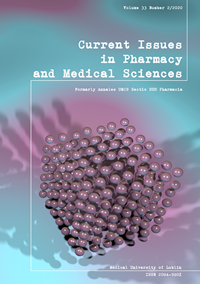Proteolytic parameter changes in the plasma of patients with bladder cancer – depending on tumor stage
DOI:
https://doi.org/10.2478/cipms-2020-0013Keywords:
bladder cancer, serine proteases, medium mass molecules, MMPs, α1A, α2MAbstract
Bladder cancer (BC) is a worldwide common disease with a high mortality rate. Recognizing the dynamic changes in plasma that proteases and their inhibitors undergo might be valuable in understanding the carcinogenesis of invasive bladder cancer and in identifying BC patients with poor prognosis. This study aims to determine the activity of the proteolytic enzyme system and their inhibitors in patients with BC. In this paper, the total proteolytic activity, the activity of matrix metalloproteases (MMPs) and serine proteases was analyzed by the method of caseinolytic activity. For detection of activity of some inhibitors of proteolysis, we used the unified method for determining the activity of alpha-1-antitrypsin (α1A) and alpha-2-Macroglobulin (α2M) in human plasma. The level of medium-mass molecules (MMM) was assessed spectrophotometrically by applying the Nikolaichik method.
The activity of MMPs was elevated in all groups of patients. Moreover, the activity of serine proteases was found to be enhanced in patients with Stage I, III and IV BC, while the activity of α1A was up by 1.4 and 1.3 times in patients with Stage I and Stage IV. The most significant increase was observed with regard to the activity of α2M in patients with I and III stages of BC. In addition, the level of MMM correlated with cancer stage. Indeed, the highest increase in the activity of protease inhibitors was observed in Stage I bladder cancer patients, which might signify their protective role at the onset of the bladder carcinogenesis. In contrast, significant growth in activity of α2M in patients with III stage of BC may point at a compensatory mechanism that inhibits tumor growth.
References
1. Ploeg M, Aben KK, Kiemeney LA. The present and future burden of urinary bladder cancer in the world. World J Urol. 2009;27(3):289-93.
2. Murta-Nascimento C, Schmitz-Dräger BJ, Zeegers MP, Kogevinas G, Steineck M, Real FX, Malats N. Epidemiology of urinary bladder cancer: from tumor development to patient’s death. World J Urol. 2007;25:285-95
3. Aggarwal N, Sloane BF. Сathepsin B: multiple roles in cancer. Proteomics Clin Appl. 2014;8(5-6):427-37.
4. Wolf K, Friedl P. Extracellular matrix determinants of proteolytic and non-proteolytic cell migration. Trends Cell Biol. 2011;21(12):736-44.
5. Heutinck KM, Berge IJ, Hack CE, Hamann J, Rowshani AT. Serine proteases of the human immune system in health and disease. Mol Immunol. 2010;47(11-12):1943-55
6. Hummel BC. Amodified spectrophotometric determination of chymotrypsin, trypsin and thrombin. Can J Biochem and Physiol. 1959;37:1393-9.
7. Nartykova VF, Paskhina TS. Unified method for determining the activity of α1-antitrypsin and α2-macroglobulin in serum (plasma) of human blood. Questions Med Chem. 1979;25(4):494-9.
8. Nikolaichik VV, Moin VM, Kirasky VV. A method for the detection of “meddle-size molecules”. Lab Delo. 1993;10:11-8.
9. Hoffman BD, Grashoff C, Schwartz MA. Dynamic molecular processes mediate cellular mechanotransduction. Nature. 2011;475:316-23
10. Pranjol MZ, Gutowski N, Hannemann M, Whatmore J. The potential role of the proteases cathepsin D and cathepsin L in the progression and metastasis of epithelial ovarian cancer. Biomolecules. 2015;5(4):3260-79.
11. Wojtukiewicz MZ, Hempel D, Sierko E, Tucker SC, Honn KV. Protease-activated receptors (PARs)--biology and role in cancer invasion and metastasis. Cancer Metastasis Rev. 2015;34(4):775-96.
12. Pavón MS, Arroyo-Solera I, Céspedes MV, Casanova I, León X, Mangues R. Silencing of plasminogen activator inhibitor-1 suppresses colorectal cancer progression and liver metastasis. Surgery. 2015;158(6):1704-13.
13. Mason SD, Joyce JA. Proteolytic networks in cancer. Trends Cell Biol. 2011;21(4):228-37.
14. Ulrich D, Ulrich F, Unglaub F, Piatkowski A, Pallua N. Matrix metalloproteinases and tissue inhibitors of metalloproteinases in patients with different types of scars and keloids. J Plast Reconstr Aesthet Surg. 2010;63(6):1015-21.
15. Rakashanda S, Rana F, Rafiq S, Masood A, Amin S. Role of proteases in cancer: A review. Biotechnol Mol Biol Rev. 2012;7(4):90-101.
16. Anariba DEI. Alpha1-Antitrypsin Deficiency. Medscape Reference. 2017. Available online at http://emedicine.medscape.com/article/295686-overview. Accessed February 2017.
17. El-Akawi ZJ, Nusier MK, Sawalha DH. Alpha-1 antitrypsin genotypes in breast cancer patients. J Health Sci. 2008;54(4):493-6.
18. Ahmed A Rehman, Haseeb Ahsan, Fahim HK. Alpha-2-macroglobulin: A physiological guardian. J Cell Physiol. 2013;228(8):1665-75.
19. Ferrer IG, Marrero A, Xavier F, Gomis-Rüth, Goulas T. α2-Macroglobulins: Structure and Function. Macromolecular Protein Complexes. 2017;83:14983.
20. Scherbina IN. The study of the diagnostic value of immunoregulatory proteins to assess the functional capacity of the fetoplacental complex with intrauterine infection. Br J Educ Scient Stud. 2016;1(23):833-8.
21. Rehman AA, Ahsan H, Khan FH. Alpha-2-macroglobulin: a physiological guardian. J Cell Physiol. 2013;228:1665-75.
22. Zorin NA, Zorina VN, Zorina RM. Role of proteins of the macroglobulin family in regulation of tumor growth. Ontogenez. 2006;37(1):12-9.
23. Lindner L, Hemdan NYA, Buchold M, Huse K, Bigl M, Oerlecke I, et al. α2-Macroglobulin inhibits the malignant properties of astrocytoma cells by impeding β-Catenin signaling. Ther Targets Chem Biol. 2010;70(1):277-87.
24. Korobov V, Bolesta I, Dika A, Korobova O, Savitsky V. Optical analysis of middle-molecular mass molecules of blood of individuals suffering from myocardial ischemia. Ukr J Phys Opt. 2012;3(1):35-42.
25. Chmielewski M, Cohen G, Wiecek A, Carrero J. The peptidic middle molecules: is a molecular weight doing the trick? Semin Nephrol. 2014;34:118-34.
26. Ishchuk TV, Raetska YaB, Savchuk OM, Ostapchenko LI. Changes blood protein composition under experimental chemical burns of esophageal development in rats. Biomed Res Ther. 2015;3(4):241-9.
27. Nagoev BS, Nagoeva MK. Implication of middle-mass molecule peptides of blood plasma in assessment of intoxication syndrome in patients with bacterial tonsillitis. Vestn Otorinolaringol. 2016;6:41-4.
Downloads
Published
Issue
Section
License
Copyright (c) 2020 Authors

This work is licensed under a Creative Commons Attribution-NonCommercial-NoDerivatives 3.0 Unported License.


